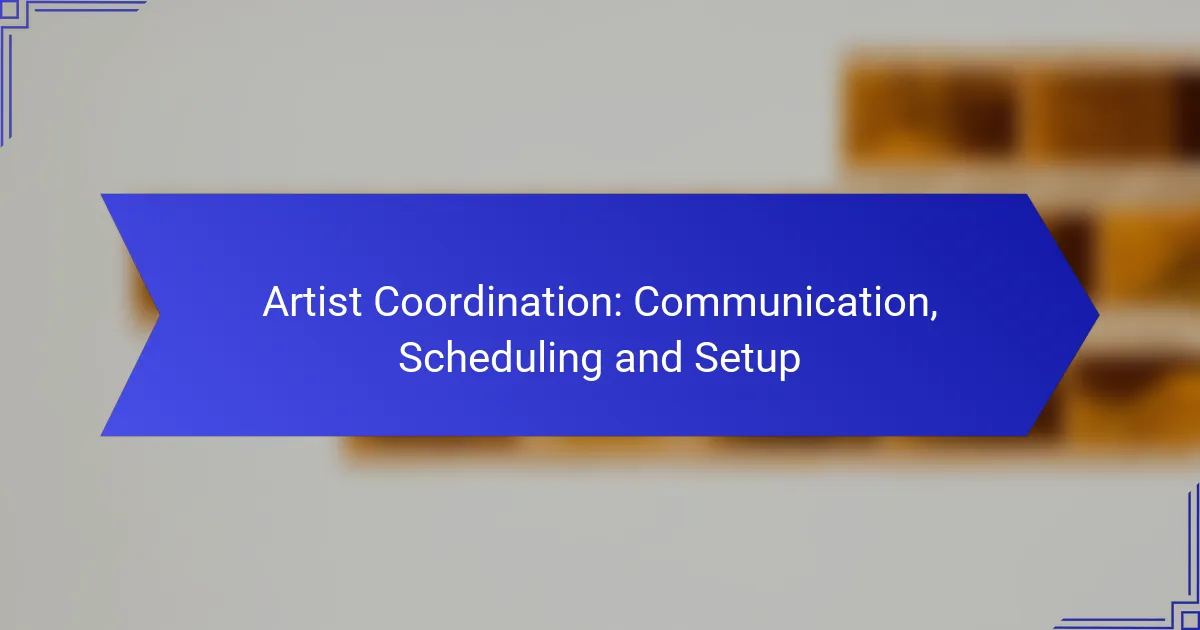Successful artist coordination hinges on effective communication, efficient scheduling, and a well-organized workspace. By utilizing structured communication methods and scheduling tools, teams can ensure alignment and streamline project management. Additionally, creating an inspiring and functional workspace is essential for fostering creativity and productivity among artists.
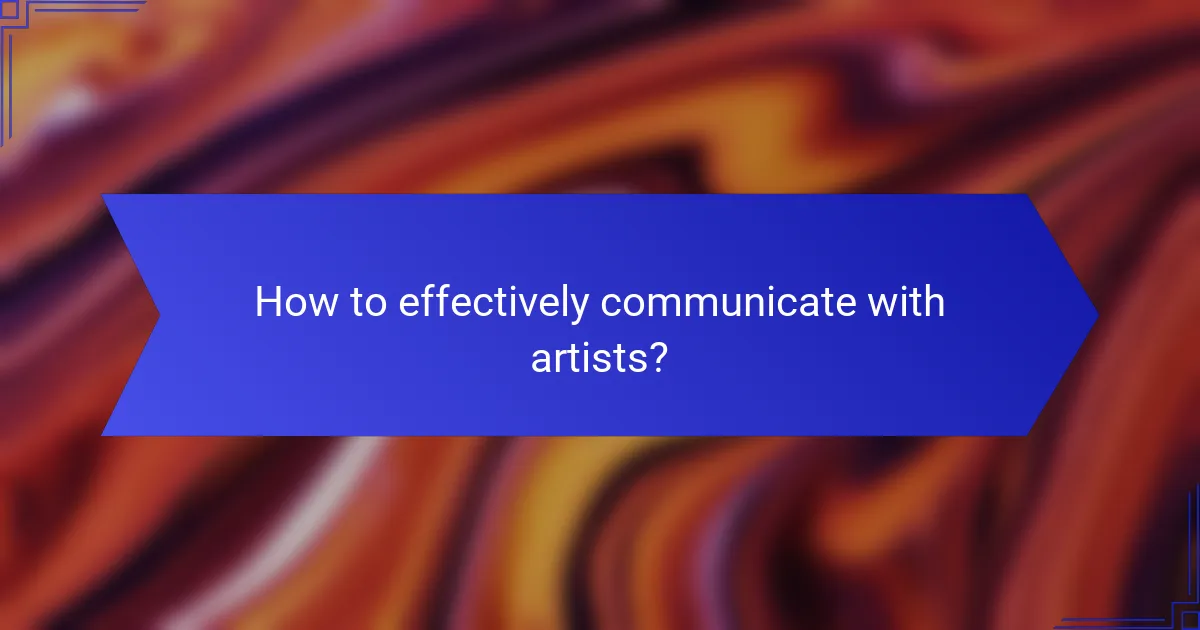
How to effectively communicate with artists?
Effective communication with artists involves clear, consistent messaging and the use of appropriate tools to facilitate collaboration. Establishing structured communication methods ensures that all parties are aligned and can work efficiently towards shared goals.
Utilize project management tools
Project management tools streamline communication and task tracking among artists and coordinators. Platforms like Trello, Asana, or Monday.com allow teams to assign tasks, set deadlines, and monitor progress in real-time.
Choosing the right tool depends on team size and project complexity. For smaller teams, simpler tools may suffice, while larger projects might benefit from more robust solutions that include features like file sharing and time tracking.
Establish clear communication channels
Defining specific communication channels helps prevent confusion and ensures messages reach the right people. Consider using email for formal updates, instant messaging apps for quick questions, and video calls for in-depth discussions.
It’s crucial to communicate which channels to use for different types of messages. For example, urgent issues might be best handled via instant messaging, while project updates could be sent through email.
Schedule regular check-ins
Regular check-ins foster accountability and keep projects on track. Weekly or bi-weekly meetings can provide opportunities for artists to share progress, discuss challenges, and align on next steps.
Keep these meetings brief and focused, ideally lasting no longer than 30 minutes. Use them to address any roadblocks and celebrate milestones to maintain motivation.
Provide detailed briefs
Detailed briefs outline project expectations, timelines, and deliverables, ensuring that artists have a clear understanding of their roles. Include essential information such as style guides, target audience, and specific goals to guide their work.
When creating briefs, consider using bullet points for clarity and including examples of desired outcomes. This approach helps artists visualize the project and reduces the likelihood of miscommunication.
Encourage feedback
Encouraging feedback creates an open dialogue and fosters collaboration. Regularly solicit input from artists on processes and project direction to ensure their perspectives are valued.
Implement structured feedback sessions where artists can voice concerns or suggestions. This practice not only improves the final product but also strengthens team dynamics and trust.

What scheduling tools are best for artist coordination?
Effective artist coordination relies on scheduling tools that enhance communication and streamline project management. The best tools offer shared calendars, task management features, and visual tracking to ensure all team members are aligned and deadlines are met.
Google Calendar for shared scheduling
Google Calendar is a widely used tool for shared scheduling among artists and teams. It allows users to create events, set reminders, and share calendars with others, making it easy to coordinate schedules across different time zones.
To maximize its effectiveness, ensure that all team members have access to the shared calendar and encourage them to update their availability regularly. This transparency helps prevent scheduling conflicts and keeps everyone informed of important dates.
Asana for task management
Asana is a powerful task management tool that helps teams organize their work and track progress on projects. It allows users to create tasks, assign them to team members, set due dates, and add comments for clear communication.
When using Asana, consider breaking down larger projects into smaller tasks to make them more manageable. Regularly review progress in team meetings to address any roadblocks and adjust timelines as necessary.
Trello for visual project tracking
Trello is a visual project management tool that uses boards, lists, and cards to help teams track tasks and workflows. Its intuitive drag-and-drop interface makes it easy to see the status of various tasks at a glance.
To effectively use Trello, create boards for different projects and categorize tasks by stages, such as “To Do,” “In Progress,” and “Completed.” This visual representation aids in quickly identifying bottlenecks and ensures that all team members are on the same page regarding project timelines.
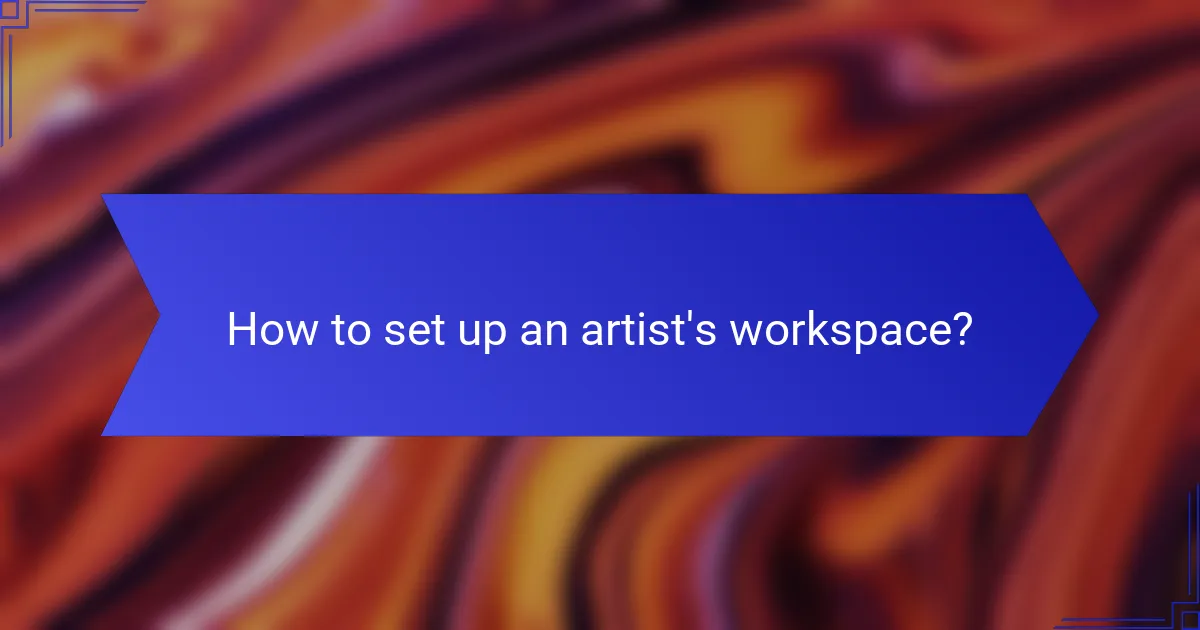
How to set up an artist’s workspace?
Setting up an artist’s workspace involves creating an environment that fosters creativity and productivity. This includes defining the space requirements, ensuring adequate lighting and equipment, and organizing materials and tools effectively.
Define space requirements
Start by assessing the size and layout of the workspace. Consider the type of art being created, as different mediums may require varying amounts of space. For instance, a painter may need a larger area for canvases and easels, while a sculptor might require room for larger tools and materials.
Evaluate the location as well. An ideal workspace should be quiet and free from distractions, with easy access to necessary utilities like water and electricity. If possible, choose a space with good ventilation to avoid inhaling fumes from paints or solvents.
Ensure proper lighting and equipment
Lighting is crucial for an artist’s workspace. Natural light is often preferred, but if that’s not available, invest in high-quality artificial lighting that mimics daylight. Use adjustable lamps to reduce shadows and ensure even illumination across the workspace.
In addition to lighting, ensure that all necessary equipment is available and in good condition. This may include easels, tables, and storage solutions. Regularly check and maintain tools to avoid interruptions during the creative process.
Organize materials and tools
Effective organization of materials and tools can significantly enhance productivity. Use shelves, bins, or carts to keep supplies easily accessible and categorized. Labeling containers can help quickly locate items when needed.
Consider implementing a system for frequently used tools and materials, keeping them within arm’s reach, while storing less frequently used items in more remote locations. Regularly declutter the workspace to maintain an inspiring and functional environment.
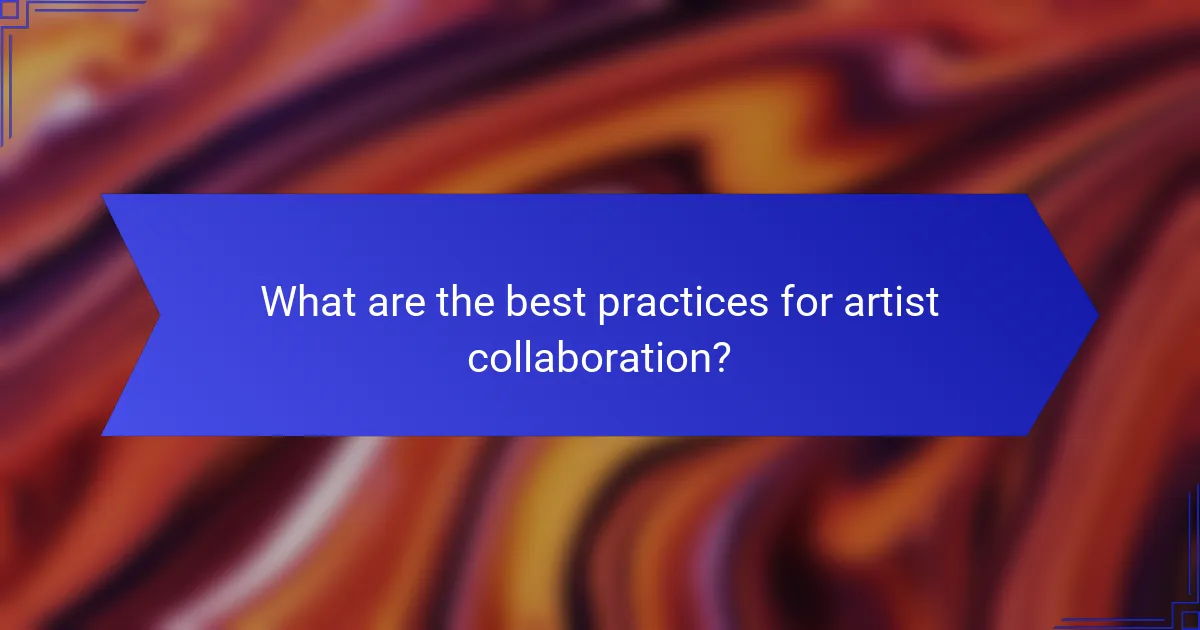
What are the best practices for artist collaboration?
Effective artist collaboration hinges on clear communication, organized scheduling, and thoughtful setup. By implementing best practices, teams can enhance creativity and productivity while minimizing misunderstandings.
Foster a collaborative environment
Creating a collaborative environment is essential for successful artist teamwork. This involves encouraging open dialogue, where all members feel comfortable sharing ideas and feedback. Regular brainstorming sessions can help stimulate creativity and strengthen team bonds.
Additionally, establishing clear roles and responsibilities can prevent confusion and ensure that everyone knows their contributions are valued. Consider using team-building activities to enhance relationships and foster trust among artists.
Utilize collaborative software like Slack
Collaborative software such as Slack can significantly streamline communication among artists. This platform allows for real-time messaging, file sharing, and project management, making it easier to stay aligned on goals and deadlines. Channels can be created for specific projects or topics, ensuring that discussions remain organized.
When using Slack, set guidelines for communication to avoid information overload. Encourage team members to check in regularly and use threads to keep conversations focused. This approach can help maintain clarity and efficiency in the collaboration process.
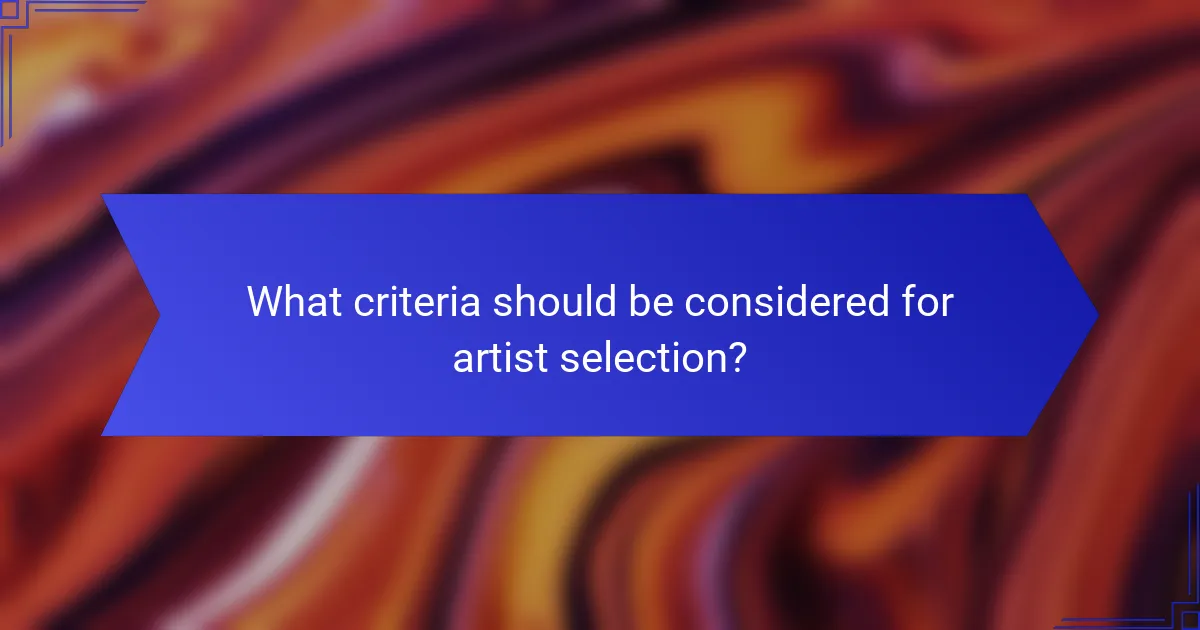
What criteria should be considered for artist selection?
When selecting an artist, consider their past work, compatibility with the project’s vision, and their ability to meet deadlines. These criteria ensure that the chosen artist can deliver quality work that aligns with the project’s goals.
Evaluate past work and portfolio
Reviewing an artist’s past work and portfolio is essential for assessing their style and quality. Look for consistency in their output and how their previous projects relate to your needs. A strong portfolio should showcase a range of skills and techniques relevant to your project.
Consider the types of projects the artist has completed before. For example, if you’re looking for a muralist, check if they have experience with large-scale works. A portfolio that includes client testimonials can also provide insight into their professionalism and reliability.
Assess compatibility with project vision
Compatibility with the project’s vision is crucial for successful collaboration. Ensure that the artist understands the concept and can translate it into their work. Discuss your goals and see how their artistic style aligns with your vision.
Engage in open dialogue about themes, colors, and techniques to gauge their enthusiasm and willingness to adapt. A good fit will not only enhance the project’s outcome but also foster a positive working relationship. Consider conducting a brief interview or discussion to clarify expectations and creative direction.
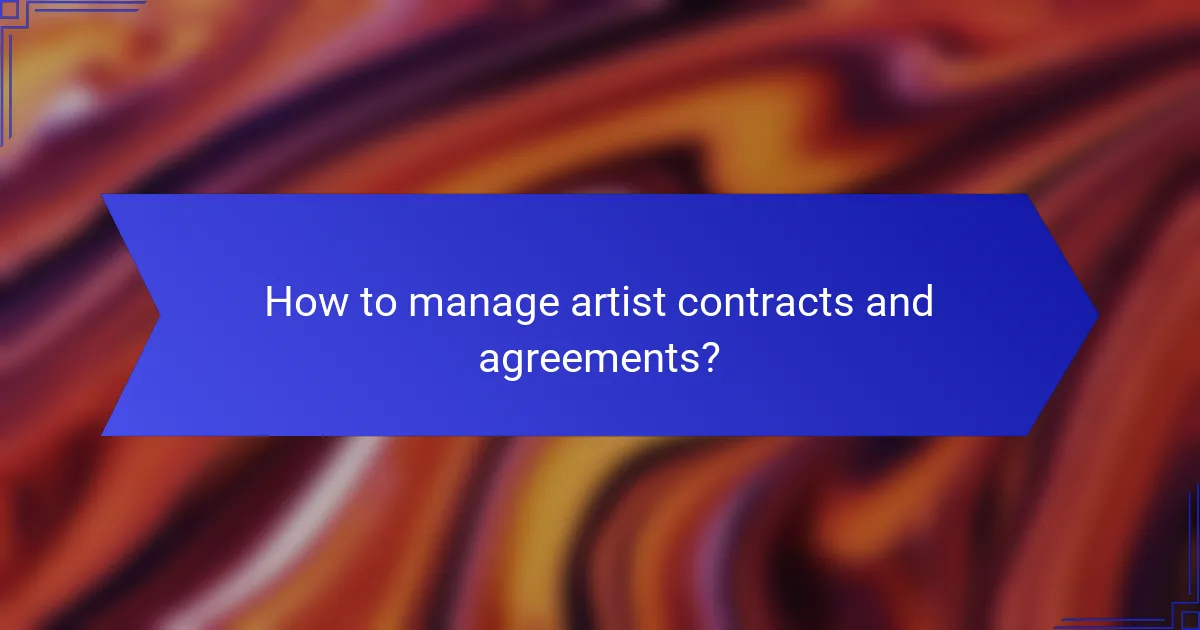
How to manage artist contracts and agreements?
Managing artist contracts and agreements involves clear communication, detailed terms, and mutual understanding. Key elements include defining roles, payment structures, and timelines to ensure all parties are aligned and protected.
Key components of artist contracts
Artist contracts should include essential components such as scope of work, payment terms, and deadlines. Clearly outlining these elements helps prevent misunderstandings and ensures that both the artist and the hiring party have a mutual understanding of expectations.
Additionally, consider including clauses for cancellation, intellectual property rights, and dispute resolution. These provisions can protect both parties in case of unforeseen circumstances or disagreements.
Negotiation tips for artist agreements
Effective negotiation is crucial for artist agreements. Start by being transparent about your budget and expectations, allowing room for discussion. This openness fosters trust and can lead to a more favorable outcome for both parties.
Be prepared to compromise on certain aspects while remaining firm on critical points. Understanding the artist’s perspective can also facilitate smoother negotiations and result in a mutually beneficial agreement.
Common pitfalls to avoid
One common pitfall is neglecting to read the contract thoroughly before signing. Always review the terms carefully and seek clarification on any ambiguous language. This diligence can prevent future disputes.
Another mistake is failing to document changes or verbal agreements. Ensure that any modifications are made in writing and signed by both parties to maintain clarity and enforceability.
